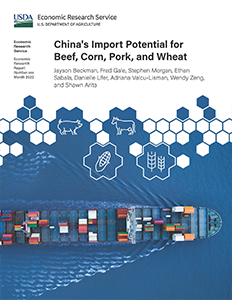China's Import Potential for Beef, Corn, Pork, and Wheat
- by Jayson Beckman, Fred Gale, Stephen Morgan, Ethan Sabala, Danielle J. Ufer, Adriana Valcu-Lisman, Wendy Zeng and Shawn Arita
- 8/25/2022
Overview
China is one of the top importers of agricultural products, but it has nontariff measures that prevent its imports from growing even larger. Economic theory suggests that a country would import products when foreign prices are lower than domestic prices, decreasing domestic prices and narrowing the “wedge” between domestic and international prices. In this report, the authors examine China’s import market potential using a price wedge approach—the difference between domestic and imported prices—for commodities that are imported by China. The report estimates the impact of removing these barriers for the four highest wedges using a global economic model. Domestic prices in China exceeded foreign prices (using the United States as an example) by large margins for the four commodities we considered, as follows: beef (58 percent), corn (64 percent), pork (213 percent), and wheat (42 percent). Estimates reveal that removing these price wedges could lead to more imports into China. Benefits would be widespread, increasing sales for producers in the United States and other exporting countries and yielding lower food prices for China’s consumers.
Download
-
Entire report
Download PDF -
Report summary
Download PDF

